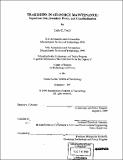Tradeoffs in Air Force maintenance : squadron size, inventory policy, and cannibalization
Author(s)
Tsuji, Luis C. (Luis Christophe), 1974-
DownloadFull printable version (9.814Mb)
Other Contributors
Management of Technology Program.
Advisor
Joseph M. Sussman.
Terms of use
Metadata
Show full item recordAbstract
The Air Force sustainment system, which includes maintenance and logistics, is facing difficult challenges. As the maintenance system is being downsized, operations tempo is increasing and private companies are entering into competition for maintenance workload. The Air Force is under intense pressure to improve maintenance performance. Attempts to change the maintenance system in a piecemeal fashion have often led to unintended consequences and global sub-optimization. High-level simulation models of the maintenance system that could illustrate critical tradeoffs could provide a valuable tool for learning, and help improve system performance in the future. This thesis uses a simple high-level simulation model to model the sustainment of a unit of C-5 aircraft. It examines high-level tradeoffs in performance and cost due to the number of aircraft, the number of spare parts, and cannibalization practices. The effects of depot repair time and the failure probability of aircraft parts are also considered. In a system like that of the Air Force sustainment system that aims to improve maintenance and logistics performance and reduce cost, yet must deal with large demand variability and must be prepared for wartime surge, cannibalization, a large number of aircraft, and a large inventory of spare parts may be necessary and may even be cost-effective.
Description
Thesis (S.M.M.O.T.)--Massachusetts Institute of Technology, Sloan School of Management, Management of Technology Program, 1999. Includes bibliographical references (p. 115-116).
Date issued
1999Department
Management of Technology Program.; Sloan School of ManagementPublisher
Massachusetts Institute of Technology
Keywords
Management of Technology Program.